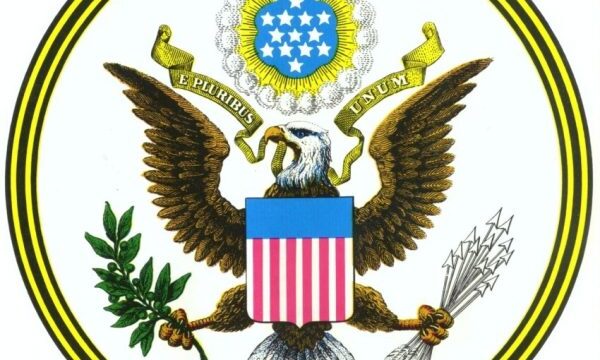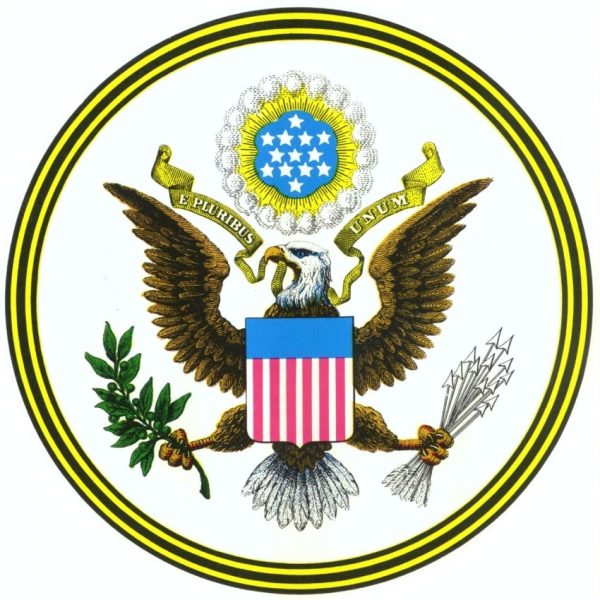Collection Highlights
Damaged Great Seals from U.S. Diplomatic Missions
These Great Seals were damaged during attacks on U.S. diplomatic missions. They are physical reminders of the dangers that Diplomatic Security Service special agents and…

The Great Seal of the United States is a unique symbol of our country and national identity. Only one authorized Great Seal is in official use and is operated by the U.S. Department of State. The Great Seal is impressed upon official documents such as treaties and commissions. The Department of State affixes about 3,000 seals to official documents yearly.
There is perhaps no better-known document in American history than the July 4, 1776, Declaration of Independence. Most Americans, however, do not know that it is our country’s first foreign policy document. While the Declaration did serve to inform the American people of the colonies’ determination to form a separate and independent nation from Great Britain, it was, as John Adams later wrote, “…a formal and solemn announcement to the world, that the colonies had ceased to be dependent communities, and become free and independent States.” This formal proclamation demonstrated globally that this “rebellion” was no civil war between Britons; rather, it was a pronouncement that the United States intended to join and engage with the world as an equal, sovereign nation. American leaders quickly sent copies to European nations, and it was translated into many languages and widely distributed.
Members of the Continental Congress also recognized that the new nation needed a formal seal to affix on official documents and passed a resolution on July 4, 1776, before adjourning.
“Resolved, that Dr. Franklin, Mr. J. Adams, and Mr. Jefferson, be a committee, to bring in a device for a seal for the United States of America.”
These illustrious founders proposed several fascinating preliminary concepts for a seal to represent the new nation, drawing on classical and biblical imagery. In an August 14, 1776 letter to his wife Abigail, John Adams recounted some of the debate. Benjamin Franklin, Adams wrote, suggested “Moses lifting up his wand, and dividing the Red Sea, and Pharoah, in his chariot overwhelmed with the waters,” and the following motto, “Rebellion to tyrants is obedience to God.” Thomas Jefferson imagined Americans as “the children of Israel in the wilderness…led by a pillar of fire by night,” alongside representations of early Britons “whose political principles and form of government” the United States assumed. Adams concentrated on Hercules, the mythical figure of strength, “resting on his club,” gazing towards a figure of virtue, and impervious to sloth and vice.

In 1782, after six years and three committees, the Continental Congress decided on a less abstract seal and incorporated a design that reflected the beliefs and values that the Founding Fathers ascribed to the new nation. Charles Thomson, Secretary of the Continental Congress, designed the 1782 seal to symbolize our country’s strength, unity, and independence. The olive branch and the arrows held in the eagle’s talons denote the power of peace and war. The eagle always casts its gaze toward the olive branch signifying that our nation desires to pursue peace but stands ready to defend itself. The shield, or escutcheon, is “born on the breast of an American Eagle without any other supporters to denote that the United States of America ought to rely on their own Virtue,” Thomson explained in his original report.
The seal shares symbolism with the colors of the American flag. In addition, the number 13 — denoting the 13 original states — is represented in the bundle of arrows, the stripes of the shield, and the stars of the constellation. The constellation of stars symbolizes a new nation taking its place among other sovereign states. The motto “E Pluribus Unum” emblazoned across the scroll and clenched in the eagle’s beak expresses the union of the 13 States.
Today the Secretary of State is the custodian of our national symbol, the Great Seal of the United States. The seal is impressed upon documents such as treaties and commissions, and it is also found on documents such as U.S. passports and the reverse of the $1 bill.
In this Diplomacy Classroom, we took a closer look at the Great Seal of the United States. NMAD Public Historian Dr. Alison Mann and Education Director Lauren Fischer discussed the importance of the seal and how it evolved to be the image now recognized around the world as a symbol of the United States. Also highlighted during the program were artifacts from NMAD’s collection that bear the Great Seal. The artifacts showed how the seal is used not only on official documents, but is affixed on U.S. missions across the globe and represented on diplomatic gifts.